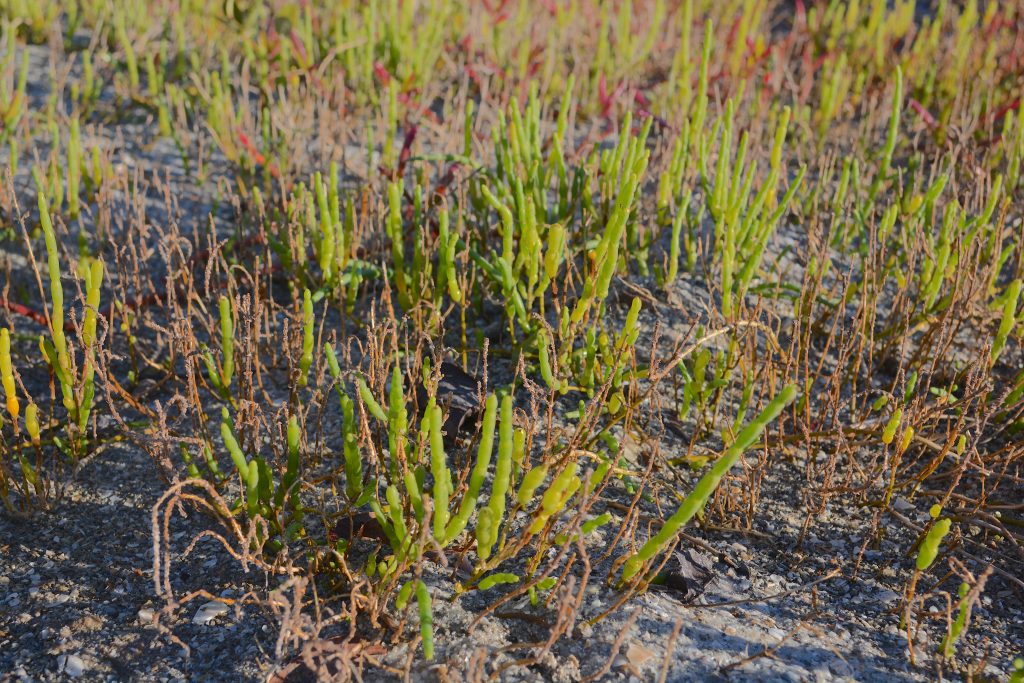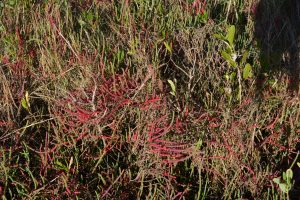
Glasswort, a tasty plant growing where others cannot. Photo by Green Deane
Salicornia bigelovii, Brackish Nibble
Glasswort does not sound like breaking glass at all, though it does crunch a bit.
Salicornia bigelovii (sa-li-KOR-nee-a big-eh-LOV-ee-eye) has been used by most indigenous people around the world. Like many other salt-tolerating plants, it grows in salt marshes, on beaches, and among mangroves. They are native to the United States, Europe, South Africa and South Asia.
There’s significant commercial interest in glasswort in that it can be watered with salt water and can produce an excellent and nutritious oil. The raw seeds themselves are not edible because of saponins, but those remain with the meal when the oil is extracted. It is similar to safflower oil in composition, has a nutty flavor with a texture like olive oil. An ash made from the plant was used in the manufacturing of glass, hence its name. Glasswort has also been used as a diuretic and an antiscorbuitic. l like it raw in salads.
Besides forager glasswort is the favorite of several butterflies particularly Lepidoptera species including the Coleophora case-bearers C. atriplicis and C. salicorniae, the latter which feeds exclusively on Salicornia. Salicornia means salt horn, referring to the plant’s branches. And Bigelovii: It was discovered in the New World by American botanist, Jacob Bigelow, right, 1787-1879. Of course, native Americans discovered it long before Jacob did. Professor Bigelow’s other claim to fame was he established the first rural garden cemetery in North America, Mount Auburn Cemetery in Cambrdge and Watertown, Massachusetts. He was not fond of doctors and was a vocal critic of their practices.
A close cousin to the S. bigelovii is the S. virginica (ver-JIN-ni-ka) meaning “of Virginia” read middle North America. Essentially the main difference is while the S. bigelovii can be stout the S. virginica tends to be trailing and forms mats on the ground. It is not as esteemed as its cousin but can be cooked and eaten the same way. However, it can be stringy so some folks like to put the cooked vegetable through a strainer to get rid of some stringiness. Another local species is S. ambigua, common on the local west coast.
Called Pickleweed and Woody Glasswort (from the sound some think it makes when you walk on it) glasswort can be found New Hampshire to Texas and up the Pacific coast. Often it turns red in the winter and red parts taste more salty. It has woody, jointed stems and leaves like fleshy sheaths. The flowers are extremely small, sunken into the joints, usually only the stamens visible. Four to 18 inches in height, it usually forms dense stands, miniature upright forests in tidal areas.

The more red the more salt. Photo by Green Deane
As with most greens, harvest when young and tender, or the growing tips. The entire glasswort grows woody as it ages, but in stages. You may find when you go to chop it that you have some with a thin woody core and fleshy on the outside. Just bend up those pieces and boil them any way. When they are done, the fleshy green exterior can be easily stripped of the inner light yellow wood. Toss the woody parts away. For raw in salads and as pickles pick the youngest parts possible and keep checking for a woody core, which you don’t want if you aren’t going to cook them. Older pink parts of glasswort can be used to make salt or for seasoning. Incidentally, the ash, which can be used for making glass and leaching lichen, is also good for making soap, especially if you don’t have hard wood ashes available for soap .
Green Deane’s “Itemized” Plant Profile
IDENTIFICATION: Glassworts are succulent, fleshy plants with opposite leaves and jointed stems, found in saline environments. Plant, 2 to 12 inches, erect, may turn red in winter. Leaves very small, scale-like. Flowers tiny, sunken into stem joints, commonly only stamens visible. Joints wider than long. Fruit small, succulent containing one seed.
TIME OF YEAR: All year round
ENVIRONMENT: Salt marshes, and along interior salt lakes.
METHOD OF PREPARATION: Young leaves and stems, raw, cooked or pickled. Oil pressed. Another species, S. perennis, is likewise usable after cooking but should be strained. Scalornia gets woody as it ages and is not edible.
HERB BLURB
Salicornia bigelovii Torr.: An Oilseed Halophyte for Seawater Irrigation
EDWARD P. GLENN 1, JAMES W. O’LEARY 1, M. CAROLYN WATSON 1, T. LEWIS THOMPSON 1, and ROBERT O. KUEHL 2. 1 Environmental Research Laboratory, 2601 East Airport Drive, Tucson, AZ 85706
2 Statistical Support Unit, College of Agriculture, University of Arizona, Tucson, AZ 85721
The terrestrial halophyte, Salicornia bigelovii Torr., was evaluated as an oilseed crop for direct seawater irrigation during 6 years of field trials in an extreme coastal desert environment. Yields of seed and biomass equated or exceeded freshwater oilseed crops such as soybean and sunflower. The seed contained 26 to 33 percent oil, 31 percent protein, and was low in fiber and ash (5 to 7 percent). The oil and meal were extracted by normal milling equipment, and the oil was high in linoleic acid (73 to 75 percent) and could replace soybean oil in chicken diets. The meal had antigrowth factors, attributed to saponins, but could replace soybean meal in chicken diets amended with the saponin antagonist, cholesterol. Salicornia bigelovii appears to be a potentially valuable new oilseed crop for subtropical coastal deserts.


